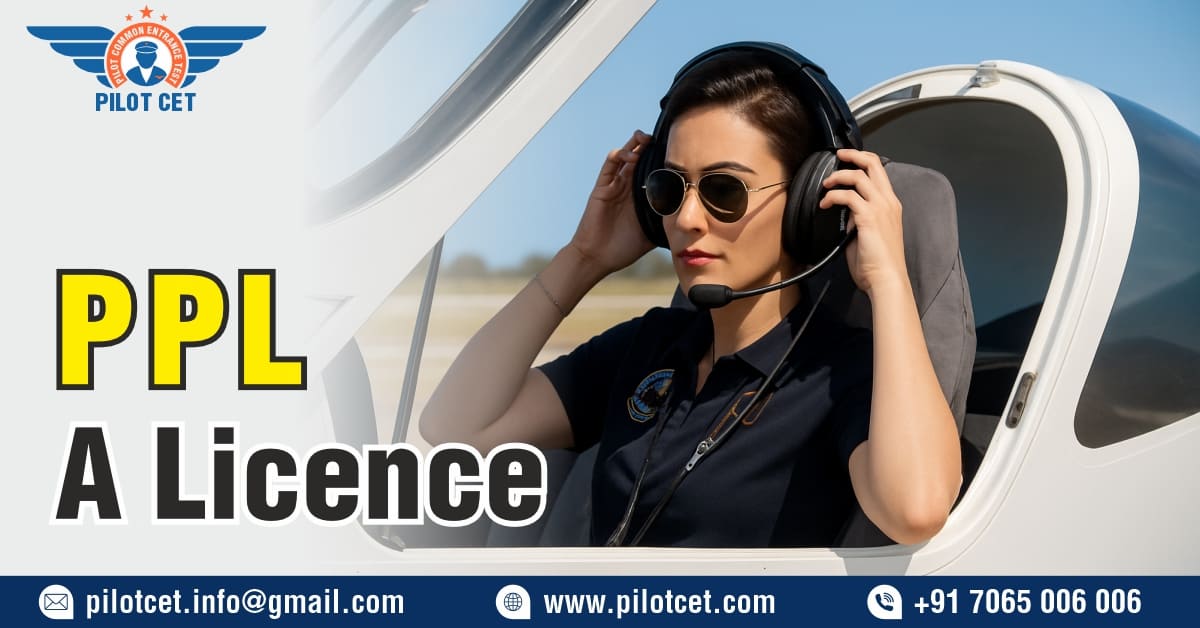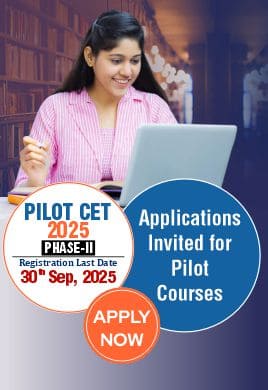
PPL (A) Licence
PPL A Licence is an aviation license which allows individuals to specifically fly an aeroplane for personal and recreational purposes. DGCA allot the license to students as it is the main regulatory body in India for aviation licenses. After completing the private pilot licence course, pilots can act as a Pilot-in-Command (PIC) which means full responsibility for operating an aircraft will be in the hand of the license holder but this license cannot be used for commercial flying or earning money purposes. PPL is recognized under ICAO rules & is valid internationally. It often serves as the first step toward advanced licenses like CPL and ATPL. To obtain PPL (A) licence students must be medically fit, complete ground modules, meet minimum flying hour requirements and pass DGCA exams along with a flying skill test. PPL is ideal licence for aviation enthusiasts, hobby flyers or aspiring pilots beginning their professional journey.
Course Duration
|
Aspect |
Details |
|
Course Duration |
6 to 12 months |
|
Notes |
Some students may finish earlier if they can fly regularly; delays can extend the course. |
Basic Requirements
To get a PPL license in India students must meet the basic requirements which are set by the DGCA. This eligibility criteria makes sure that whether future pilots are prepared for theoretical or practical aspects of training as well as meet international aviation standards.
|
Requirement |
Details |
|
Full Form |
Private Pilot Licence (Aeroplane) |
|
Age |
Minimum 17 years at the time of issue of the PPL. |
|
Educational Qualification |
Must have passed 10th standard or equivalent. For those planning CPL later, PCM at 10+2 level is recommended. |
|
Medical Fitness |
Must hold a valid DGCA Class 2 Medical Certificate. (Class 1 Medical required if continuing to CPL). |
|
Language Proficiency |
Must be able to read, write, understand, and speak English as per ICAO standards. |
PPL (A) Syllabus
PPL (A) syllabus includes both theoretical and practical knowledge. It includes study of 6 DGCA modules & 40 hours flying training on real aircrafts. Below is given detailed info of PPL course syllabus:
DGCA Modules
|
Module |
Description |
|
Air Regulations |
Rules and laws governing civil aviation, aircraft operations and airspace. |
|
Aviation Meteorology |
Study of weather, forecasts and their impact on flight planning and safety. |
|
Air Navigation |
Principles and techniques of navigating an aircraft safely. |
|
Technical General |
Basics of aircraft systems, engines, instruments and general operational knowledge. |
|
Technical Specific |
Detailed study of the specific aircraft type used in training. |
|
RTR |
Training in aviation communication, radio procedures and ATC phraseology. |
Flying Training Requirements
To get a PPL in India student have to complete 40 hours of flying training. These standards are set by the DGCA. These hours are made to ensure that the student gains sufficient practical experience in both controlled and solo flying:
- Dual flying- 20 hours of dual flying alongside a certified instructor to learn aircraft handling, takeoffs, landings and emergency procedures.
- Solo flying - 10 hours of solo flying alone to gain confidence and demonstrate the ability to control the aircraft independently.
- Cross-country flying (solo) - 5 hours flying solo over longer distances, navigating between airports and practicing route planning.
- Instrument flying (basic) - 5 hours instrument flying training is required to fly using only instruments for navigation, especially under poor visibility conditions.
Examination & Licensing
After completing PPL training students have to pass the DGCA examinations and flying test to get their PPL licence. This process includes written exams, practical flying test with a certified examiner and verification of medical fitness. A successful completion will make the student eligible to become an aircraft Pilot-in-Command (PIC) operating within the DGCA regulations.
|
Stage |
Description |
|
Written Exams |
Students must pass DGCA-conducted written examinations in subjects like Air Regulations, Air Navigation, Aviation Meteorology, Aircraft & Engines and Technical General |
|
Flying Test |
Practical assessment by a DGCA-certified examiner covering takeoffs, landings, solo flying, cross-country navigation, and basic instrument flying. |
|
Licence Issuance |
After passing written exams, flying test and holding a valid DGCA medical certificate, DGCA issues the Private Pilot Licence (PPL) allowing the holder to fly as Pilot-in-Command (PIC |
Skills Required
- Strong hand-eye coordination: It is important for controlling the aircraft during takeoff, landing and maneuvers etc.
- Knowledge of aircraft systems: Understanding engines, instruments & operations for safe flying.
- Good communication skills: Clear interaction with ATC, instructors and co-pilots.
- Quick decision making: Reacting correctly & making quick decisions in emergencies or unexpected situations.
- Situational awareness: monitoring surroundings, weather & air traffic for safe navigation.
- Problem solving skills: troubleshooting technical or in flight issues independently.
- Focus: maintaining attention during long flights and complex procedures.
- Basic navigation skills: using maps, instruments & radio aids for planning and route following.
- Physical and mental fitness: maintaining health to handle the demands of flying.
PPL (A) Fee
PPL (A) fee is different in India from other countries and flying school. In India course fee typically starts from INR 10-15 Lakhs while fees abroad differ depending on the local regulations and training standards etc. This course fee usually includes ground classes, flying hours, simulator training, medical exams and licensing fees etc. Below is given PPL course fee country wise:
|
Country |
Approx. Course Fee |
|
India |
INR 10-15 Lakh |
|
USA |
INR 9-12 Lakh |
|
UAE |
INR 3-4 Lakh |
|
Australia |
INR 18-24 Lakh |
|
UK |
INR 12-17 Lakh |
|
Canada |
INR 8-11 Lakh |
PPL Application & Docs
For getting the PPL (A) licence students apply and application & have to provide some documents along with it. Such documents guarantee the seamless process of application and assist the aviation authority in checking whether you are eligible to be trained and licensed.
|
Document |
Purpose |
|
Birth Certificate or Valid ID Proof |
Confirms age and identity of the applicant |
|
10TH OR 12th Mark sheet |
Proves educational eligibility for PPL |
|
Medical Fitness Certificate |
Shows candidate is physically and mentally fit to fly |
|
Flight Training Record (Logbook) |
Documents flying hours and training progress |
|
Passport-Sized Photos |
Used for official records and licensing |
PPL (A) is made to give permission to holders flying aeroplane for personal or recreational purposes only. PPL holders can fly the private aircraft, join aero clubs or take friends and family on leisure flights. While a PPL does not permit commercial flying but it serves as an important base for further pilot training like CPL. Additionally, since PPL is recognized under ICAO standards it can be converted in other countries as well and allow pilots to continue their training or fly internationally under specific regulations. And further anyone can advance it into a commercial pilot license to make their career in pilot profession.

Recent Articles
- What is Commercial Pilot Course?
- PPL (A) Licence
- CPL Holder Meaning
- What are the requirements to become a pilot?
- What is a Commercial Airline Pilot?
- CPL Aviation
- What should I do after 12th to become a pilot?
- What is the eligibility to become a pilot?
- what is a commercial pilot license?
- Pilot Eligibility for Female
Frequently Asked Questions
A PPL A Licence is a Private Pilot Licence for Aeroplanes. It allows you to fly small aircraft for personal use. It is the first step toward a pilot career.
read more..
You should apply because it helps you start your flying journey. It builds your basic flying skills. It also opens doors for higher pilot licences.
read more..
You can get a ppl a licence by joining a DGCA approved flying school. You must complete ground classes flight training and exams.
read more..
You can start training after turning 17 years old. Many students begin right after school. It is a great time to enter aviation.
read more..
You must pass Class 10+2 with any stream. Basic English and Physics knowledge helps. Good medical fitness is also needed.
read more..
Medical tests ensure you are healthy to fly safely. It checks eyesight hearing and general health. It protects you and passengers.
read more..
Training usually takes 3 to 6 months. It depends on weather flying hours and your study speed. Most students complete it smoothly.
read more..
Commercial Pilot License Commercial Helicopter Pilot License Private Pilot License Private Helicopter Pilot License
